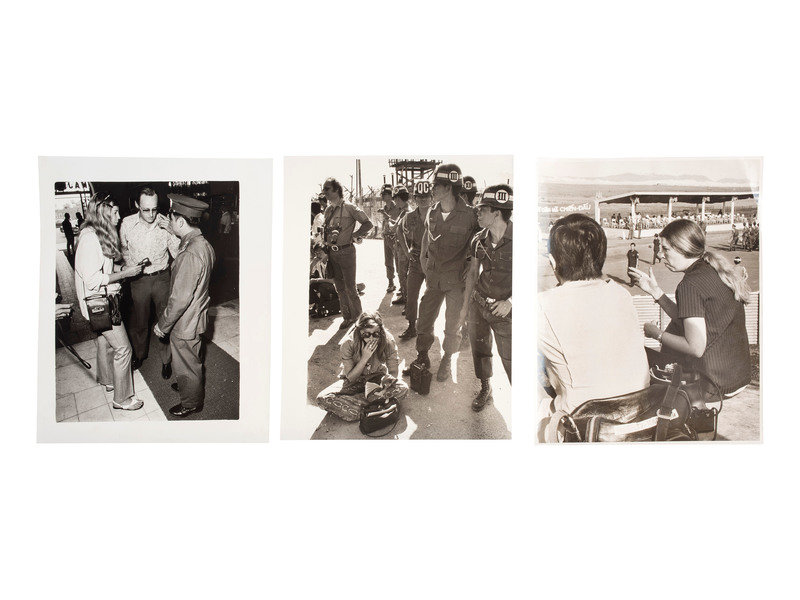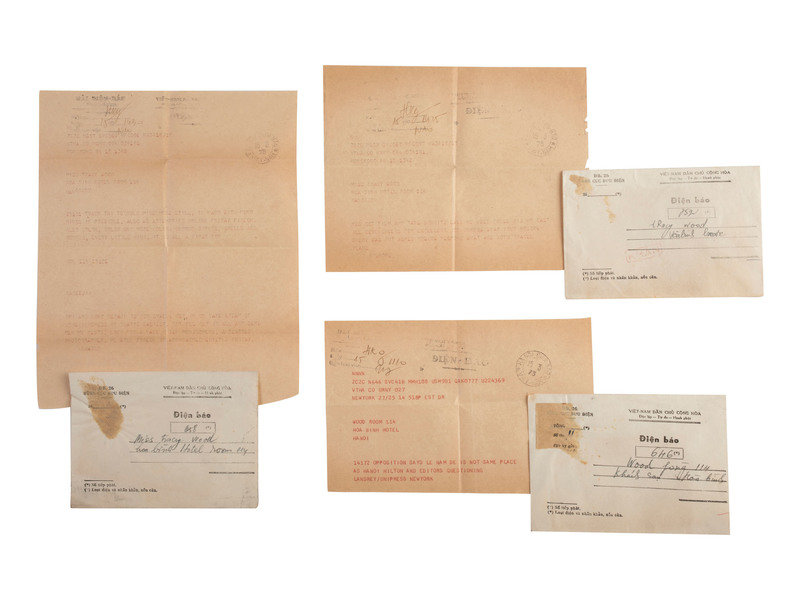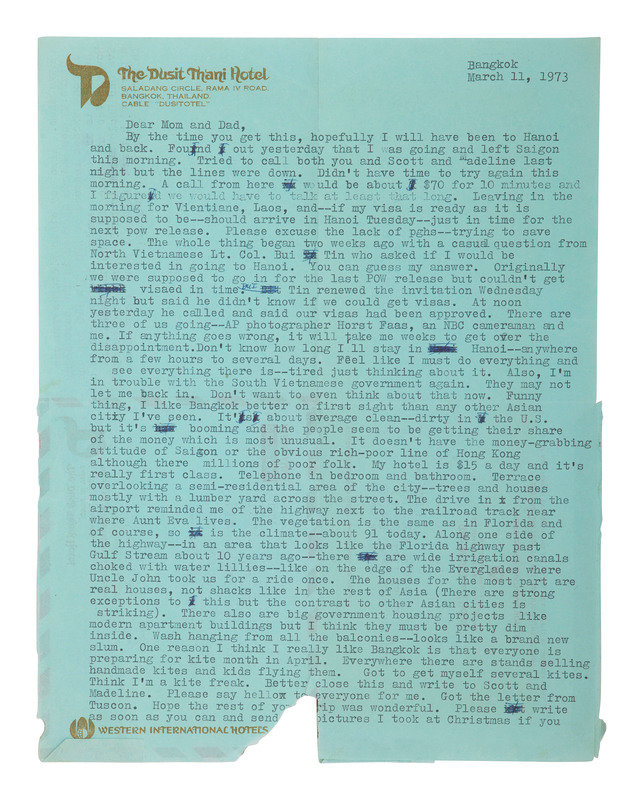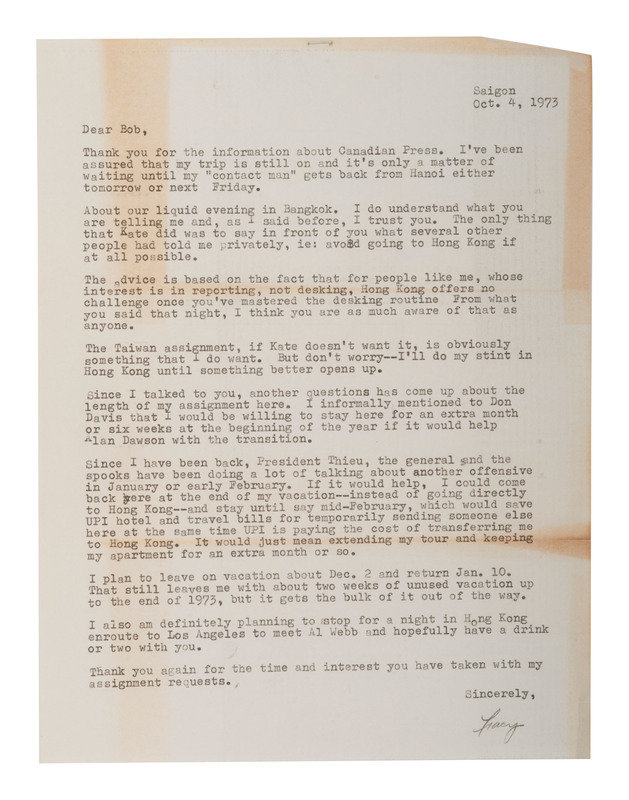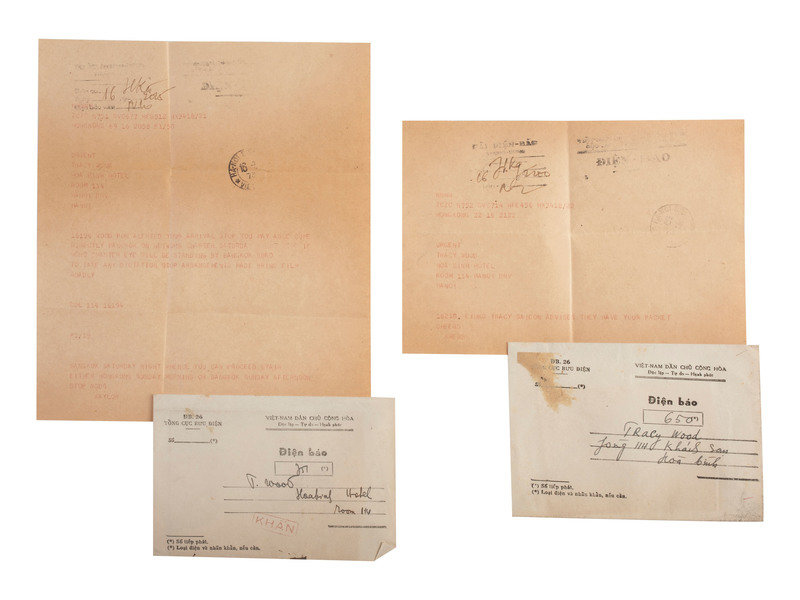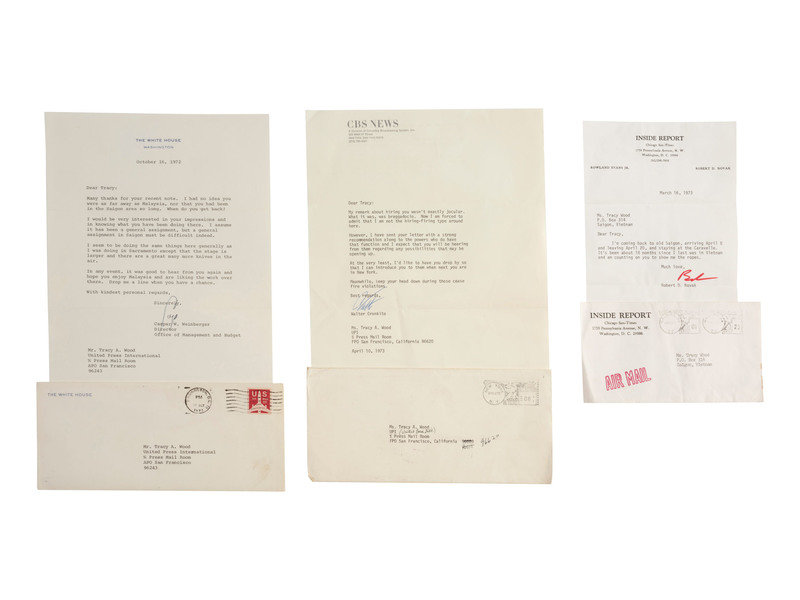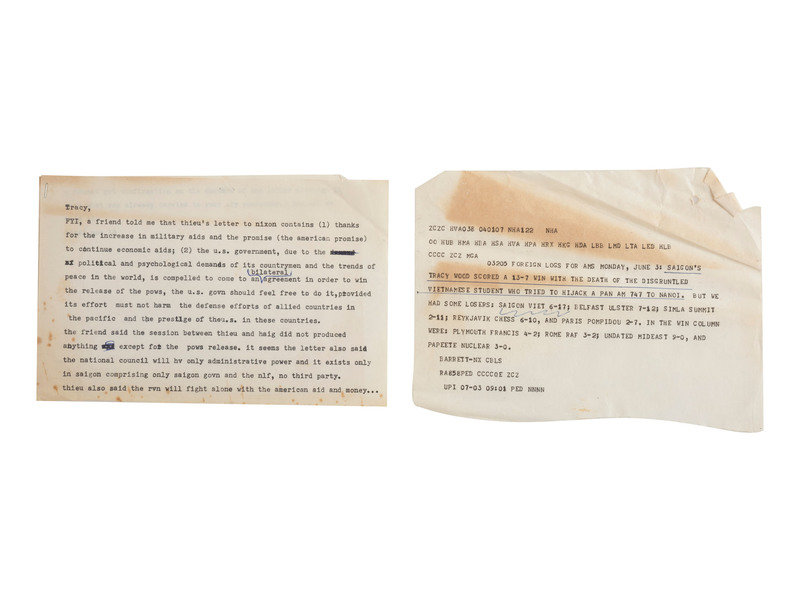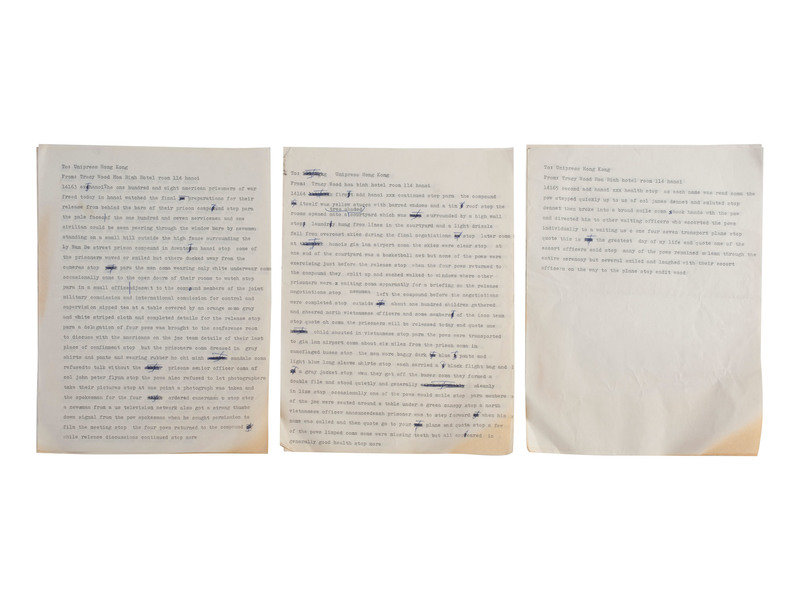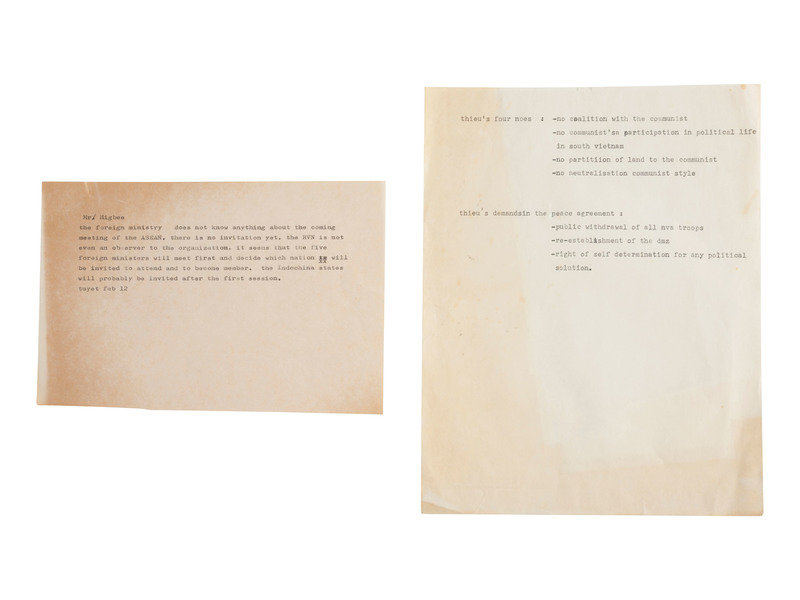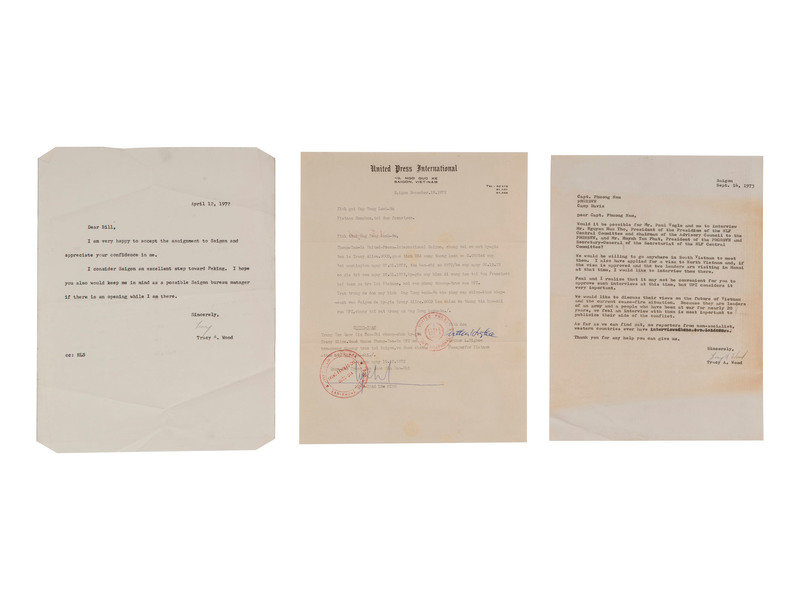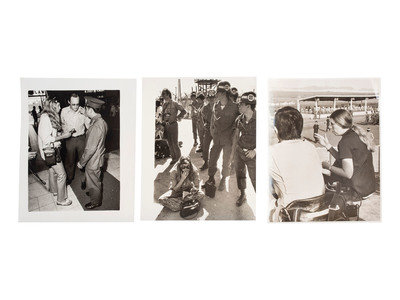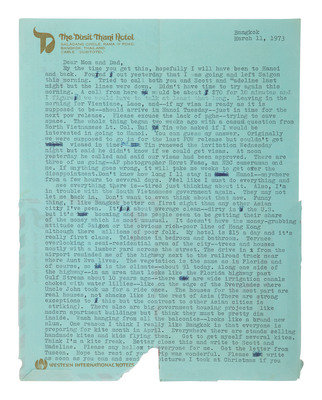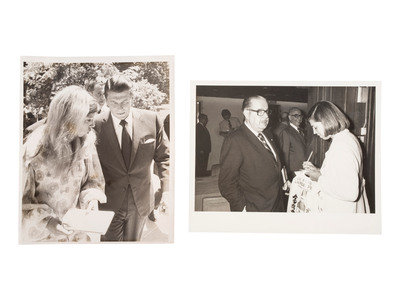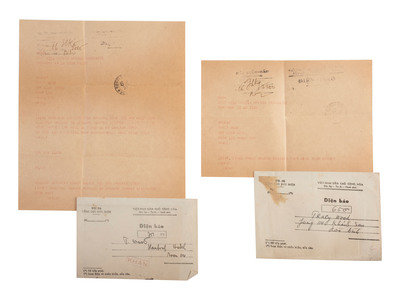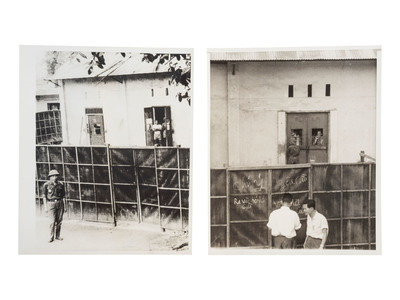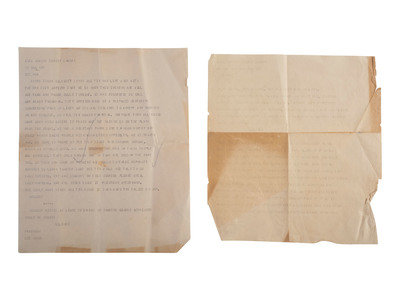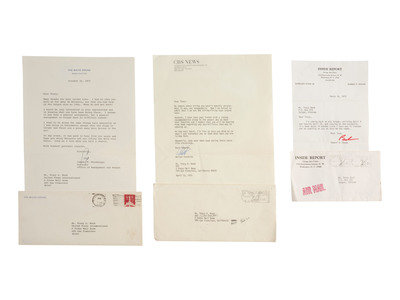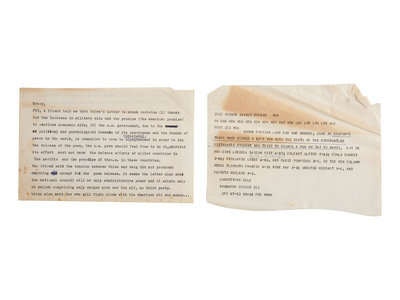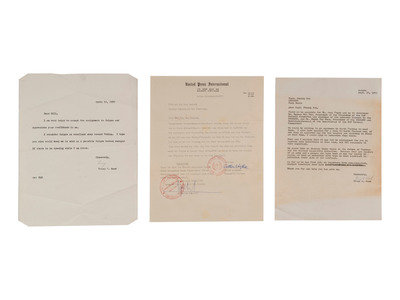Lot 550
[VIETNAM WAR] - [WOMEN]. Vietnam War-era papers of Pulitzer Prize-winning combat journalist Tracy A. Wood (1943-2020), including documents related to the 1973 release of American POWs in Hanoi.
Sale 960 - American Historical Ephemera & Photography
Nov 15, 2021
11:00AM ET
Live / Cincinnati
Own a similar item?
Estimate
$15,000 -
25,000
Price Realized
$25,000
Sold prices are inclusive of Buyer’s Premium
Lot Description
[VIETNAM WAR] - [WOMEN]. Vietnam War-era papers of Pulitzer Prize-winning combat journalist Tracy A. Wood (1943-2020), including documents related to the 1973 release of American POWs in Hanoi.
Extensive archive of nearly 700 items from the estate of journalist Tracy A. Wood who served as a foreign correspondent in Saigon for United Press International (UPI) from May 1972 through February 1974. Wood was one of a small number of female combat reporters to cover the Vietnam War, and was the only woman ever elected president of the Association of Foreign Correspondents in Vietnam. Includes personal correspondence, photographs, teletype dispatches, field notebooks, background research, maps, and draft stories, as well as press credentials, expense reports, pay stubs, receipts, travel documents, and more. Collection is highlighted by documents and photographs related to Wood’s coverage of “Operation Homecoming,” the return of nearly 600 American prisoners of war held by North Vietnam following the January 1973 signing of the Paris Peace Accords. Conditions vary, but generally good. Various places, 1964 – ca 1980s (bulk 1972-1975).
Though there were small numbers of women war correspondents in previous conflicts, the Vietnam War represented a watershed moment as female reporters pushed the boundaries of what was considered acceptable for a woman to cover. Several early pieces in the collection reflect the sexism of the era that Wood worked to overcome. Her designation as a political journalist in Vietnam - not a combat reporter – similarly was indicative of a reluctance on the part of her editor to place Wood in a combat zone. Wood did greatly expand the scope of her assignment venturing into combat zones and working closely with the military, but ultimately it was the unique relationships formed with political entities on the opposing side of the conflict that proved most significant to her reporting. She was present during the run-up to the Paris Peace Accords and her archive reflects documentation and references to key milestones at a pivotal point in the conflict. Most significantly, because the US government would not allow press coverage of the prisoner releases, Wood began to work her North Vietnamese and Viet Cong contacts hoping to gain access. Her persistence paid off. Along with Pulitzer Prize-winning AP photographer Horst Faas, a West German citizen, and Chris Callery, a British cameraman for NBC, Wood was granted a visa from the North Vietnamese to cover the March 14, 1973, release of 108 captives including Lt. Cmdr. John McCain. She was the only American and the only US reporter there to cover the release. Two days later, she covered the release of another 32 prisoners which included Floyd “Jim” Thompson, the longest serving POW in American history.
Included in the archive is a 6pp document titled “Military Personnel” listing the 108 POWS released on March 14, 1973. The document identifies names, ranks, serial numbers, branch of service, birth date, place of birth, as well as date and place of capture. The list is organized chronologically by date of capture with those imprisoned the longest at the top of the list. Number 41, “John Sidney McCain,” appears at the top of page 3. A second document lists the “Military Personnel” released on March 16, 1973. Alongside the name “Ronald L. Ridgeway” is a handwritten note “today you will see him alive.” Ridgeway was declared dead by the US military after he went missing in Quang Tri in 1968; it was not known that he was held captive until his name appeared on a POW release list provided by the North Vietnamese.
Log notes, 6 typed pages, sent by Wood via teletype to UPI Foreign Editor Wilbur G. Landry and UPI Asian News Editor Daniel F. Gilmore after the prisoner releases provide behind-the-scenes details of her time in Hanoi. “At the prison we were told not to speak to the prisoners or try to contact them. That was really hard. Some of them would wave but we were afraid to wave back. When four pows [sic] went into an office to complete final negotiations, eye [sic] stood less than a foot behind them but didn’t dare even say hello. They would look at us and then look away.” She describes an American officer who was willing to smuggle her film and tapes to Clark Air Base in the Philippines where the flights would be taking the POWS, a tour of Hanoi with the mayor Dr. Tran Duy Hung, and indicates she received a tour of “the [Hanoi] hilton [sic]” before collecting her things to head to the airport.
Wood was granted a second visa by the North Vietnamese to cover the final POW release which occurred on March 29, 1973, and was given permission to allow up to 30 additional journalists to accompany her. With competition for covering the final release fierce amongst competing news outlets, Wood learned that legendary broadcaster Walter Cronkite and CBS had booked all available charters into Hanoi but were still awaiting visas. Wood then worked with her UPI colleagues to negotiate transport to Hanoi on one of Cronkite’s planes while UPI arranged for the travel of journalists on Wood’s visa. In the end, as documented on a teletype dispatch included in the archive, 26 journalists traveled to Hanoi on Wood’s visa. Of the nearly 90 teletype dispatches included in the collection, more than 70 date to Wood’s March 1973 trip to Hanoi and later arrangements for the final POW release/charter to Hanoi.
Additional documents associated with the POW release include typed drafts of Wood’s reporting from Hanoi, a 9pp typed “Expense account for trips to Hanoi,” and a field notebook that appears to have been used by Wood on her Hanoi trips.
[With:]
30 photographs, all black and white, sizes range from 4 x 5 in. to 11 x 14 ¾ in., most 8 x 10 in. Condition generally good.
Photography highlights include the following: 4 undated photographs from POW releases, 2 showing prisoners looking out from behind bars of a prison, likely Hoa Lo prison “the Hanoi Hilton,” 1 showing tour of prison interior with a POW in right foreground, and a haunting photograph of an unidentified American POW dressed in the Vietnamese-issued clothing prior to release, standing surrounded by a crowd of military and civilian onlookers; 13 photographs of Tracy working in the field; a signed photo of Pulitzer Prize-winning photographer David Hume Kennerly working in the field with his photography equipment, inscribed in black marker “To Tracy / Love & Kisses / Dave”; a 5 x 8 in. black & white photograph presumably taken by AP journalist Richard Pyle showing the back of Wood with fellow journalists including Walter Cronkite in Hanoi for final POW release, housed in an envelope addressed to “Ms. Tracy Wood / UPI / Saigon” and accompanied by a personal note from Pyle; and an 8 x 10 image of Wood walking alongside Ronald Reagan with notebook and pen in hand (ca 1970-71).
102 negatives including the following: images of Wood with journalists in Hanoi for the final POW release; rural and urban scenes featuring Vietnamese subjects; American soldiers; and a “United Press International” envelope with approx. 10 negatives dated 11-7-73, typed description identifying Tracy Wood as “Cameraman,” and noting that “all the pictures are of lon nol [sic]” … “the dark ones were inside where he was inspecting the weapons captured from the rebels during fighting for kompong cham. ” Cambodian politician and General Lon Nol served twice as Prime Minister of Cambodia and later as a self-appointed, authoritarian Marshal of Cambodia.
[Also with:]
Approximately 200 pieces of personal letters and professional correspondence including 16 letters signed by Wood and spanning her assignment in Vietnam. On 12 April 1972, Wood writes to UPI Foreign Editor Bill Landry, accepting her much-coveted assignment in Saigon, though already thinking ahead to her next assignment: “I consider Saigon an excellent step toward Peking. I hope you also would keep me in mind as a possible Saigon bureau manager if there is an opening while I am there.” In one of her earliest letters from Saigon, written on 18 July 1972, Wood describes some of her UPI colleagues: UPI’s Saigon Bureau Chief Arthur Higbee “former writer for Newsweek, single (divorsed) [sic] an ex-patriot type whose lived most of his adult life overseas but a pretty nice guy”; David Kennerly “25—winner of the Pulitzer in photography this year, UPI photo bureau chief in Saigon, a happy-go-lucky kid who is a lot of fun and undoubtedly has a great future”; Paul Vogle “a freelancer who speaks fluent Vietnamese”; Barney Seibert “probably the most difficult person for me to get along with”; Mr. Tuyet “our interpreter-political expert”; and Mr. Duc “one of three Vietnamese teletype operators who still correct my spelling even though they can’t read English.” Wood writes from Bangkok on 11 March 1973, the day after she learned she received North Vietnamese permission to go to Hanoi for a POW release: “The whole thing began two weeks ago with a casual question from North Vietnamese Lt. Col. Bui Tin who asked if I would be interested in going to Hanoi. You can guess my answer…. At noon yesterday he called and said our visas had been approved. There are three of us going – AP photographer Horst Faas, an NBC cameraman and me. If anything goes wrong, it will take me weeks to get over the disappointment.”
Letters in the collection clearly demonstrate Wood’s tenacity and the danger inherent in her reporting. A letter from Major Gilbert L. Whiteman, USAF, Public Affairs Briefer, dated 23 November 1972, sent to Arthur Higbee commends Wood on her reporting noting that “Miss Wood gains her experience by endangering her own life while flying actual combat missions with the Vietnamese Air Force.” Whiteman writes directly to Wood on 20 December 1972, noting a difficult press briefing and disgruntled press who feel that they are not being adequately informed of military matters. He closes in the hopes that he will see Wood again soon, saying she is “among the best journalists over here [Vietnam]. You work for your stories and you write them well!”
Wood’s correspondent friends in the press corps around the globe are represented in the collection. Writing from Saigon in May 1974 following Wood’s departure to UPI’s Hong Kong office, Paul Vogle writes that Wood’s departure “really left a hole in our lives.” Correspondence reveals similar sentiments among colleagues each time that Wood moved to a new assignment. Additional UPI staff members referenced in the collection are Al Dawson, Robert Page, Al Kaff, Daniel Gilmore, Frank Beatty, and Kate Webb. Personal letters to Wood from notables Walter Cronkite, Caspar Weinberger, Robert Novak, and David Packard are also included in the correspondence.
[Also with:]
2 maps from Department of Defense both titled “Joint Operations Graphic (Air)”; 2 maps from the Army Corps of Engineers, one of “Quang Tri” and the other of “Ba Long”; approx. 2 dozen press credentials spanning 1966-1976; 2 boxes of Wood’s UPI business cards from her Saigon office, double-sided with name and information printed in English and then verso with Vietnamese; invitations to social gatherings; a UPI style guide and reporting resources; background on the political situation in Vietnam and significant political and military figures including a briefing book on the Viet Cong in South Vietnam from the US Information Service; an audio tape of ca 1973 South Vietnam government press briefing; a full list of COSVN (Central Office for South Vietnam) leadership, notable due to speculation from some at the time that the organization might not have existed; a LIFE business card from David Kennerly; Wood’s personal copy of War Torn, an anthology of stories from women reporters who covered Vietnam; and a small number of documents and ephemera associated with Wood’s reporting for the Los Angeles Times and earlier political reporting in California.
AN IMPORTANT ARCHIVE OFFERING A UNIQUE PERSPECTIVE ON A CRITICAL MOMENT IN AMERICAN MILITARY HISTORY AND ON A WATERSHED MOMENT FOR WOMEN REPORTERS
Born 21 August 1943 in Rahway, New Jersey, Wood attended the University of Missouri majoring in geography and religion. Upon graduation she spent 15 months working for the City News Service of Los Angeles before joining UPI in Sacramento in December 1966. Wood covered the California State Assembly and the US Senate and California gubernatorial campaigns until transferring to New York City in September 1971. There she worked on the UPI Foreign Affairs desk at a time when UPI was one of the world’s largest news organizations. Woods was assigned as a staff correspondent with UPI Saigon, was a news editor in Hong Kong, and a foreign correspondent throughout Asia before returning to the United States where she became an investigative reporter for the Los Angeles Times. She was part of the team that won a Pulitzer Prize for coverage of the Rodney King riots. After working as editor-in-chief of Ms. Magazine, she continued working as an investigative reporter with various news outlets until her death in 2020.
Condition Report
Contact Information
Auction Specialist

